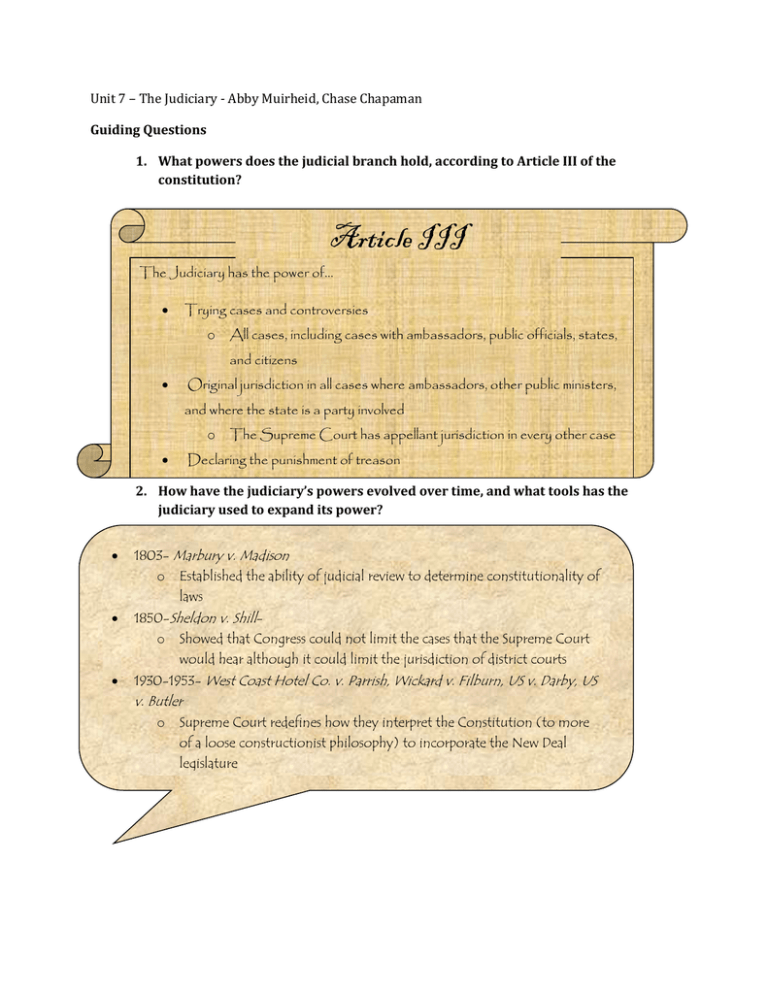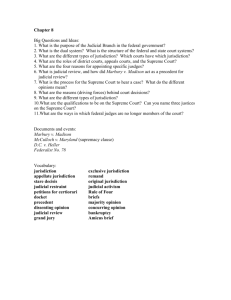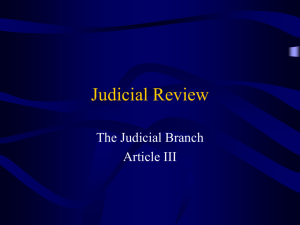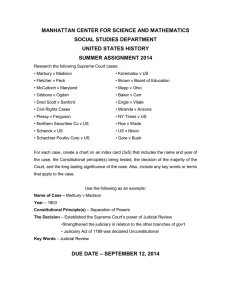Unit 7 – The Judiciary - Abby Muirheid, Chase Chapaman Guiding
advertisement

Unit 7 – The Judiciary - Abby Muirheid, Chase Chapaman Guiding Questions 1. What powers does the judicial branch hold, according to Article III of the constitution? Article III The Judiciary has the power of… Trying cases and controversies o All cases, including cases with ambassadors, public officials, states, and citizens Original jurisdiction in all cases where ambassadors, other public ministers, and where the state is a party involved o The Supreme Court has appellant jurisdiction in every other case Declaring the punishment of treason 2. How have the judiciary’s powers evolved over time, and what tools has the judiciary used to expand its power? 1803- Marbury v. Madison o Established the ability of judicial review to determine constitutionality of laws 1850-Sheldon v. Shillo Showed that Congress could not limit the cases that the Supreme Court would hear although it could limit the jurisdiction of district courts 1930-1953- West Coast Hotel Co. v. Parrish, Wickard v. Filburn, US v. Darby, US v. Butler o Supreme Court redefines how they interpret the Constitution (to more of a loose constructionist philosophy) to incorporate the New Deal legislature 3. How is the judicial branch organized, and how does this impact the political process and policy implementation? Supreme Court Highest State Courts Court of Appeals State Appellate Courts District Courts State Trial Courts District Courts- created in 1789 o 94 total throughout the 50 states, Puerto Rico, the Virgin Islands, Guam, Washington DC, and the Northern Marina Islands o Serve as trial courts at the federal level o Seen as “enforcers” to policies implemented by SCOTUS Court of Appeals- created in 1891 o 13 total Each in separate districts of the US o Only have appellate jurisdiction o May only review decisions from lower courts Supreme Court- established in Constitution o Highest court with final authority Both original and appellate jurisdiction o Cases come from both federal and state courts o Most likely court to be involved in new policy making and implementation 4. What is the relationship between the judicial branch and the other branches of government, and how has the balance of power shifted over the course of American history? 1789-1801 o The Supreme Court has little prestige and few cases and very minor 1801-1835 o 1803- Marbury v. Madison establishes judicial review giving the judicial branch the power to check the legislative branch o Makes several rulings about the balance of power between the federal government and the states 1836-1864 o 1850- Sheldon v. Shill establishes that Congress can limit the jurisdiction of district courts but not the jurisdiction of the Supreme Court 1930-1953 o 1935- SCOTUS gains its own accommodation! o SCOTUS changes its interpretation of the Constitution to help facilitate the New Deal legislation o WWII- Court favors government power 1953-1969 o Expands the force of civil liberties according to the Constitution o Supplies government with an unbroken run of antitrust victories 1986-2005 o 2000- Bush v. Gore to find the next president was very controversial 5. How does the judicial branch interact with political parties, interest groups, the media, and state and local governments (including types of federalism)? Supreme Court Justices hold their job under the tenure of good behavior in an attempt to avoid biases in the court District court judges are elected by the people and the legislature while federal court judges are appointed by the president and confirmed by the Senate 1803- Marbury v. Madison establishes judicial review giving the judicial branch the power to check the legislative branch 1850- Sheldon v. Shill establishes that Congress can limit the jurisdiction of district courts but not the jurisdiction of the Supreme Court Interest groups file amicus curiae briefs to argue in favor of an issue o Interest groups also file lawsuits against the government or other parties Judicial branch only interprets the law- it’s up to the legislative and executive branches to implement it The judicial branch can be influenced by the popular opinion portrayed in the media Vocab Words https://play.kahoot.it/#/?quizId=470ed3dc-c37d-42b2-94e0-2de8b67029ec Court Cases https://play.kahoot.it/#/?quizId=041e1b72-f522-4c02-9706-10a217f87647








